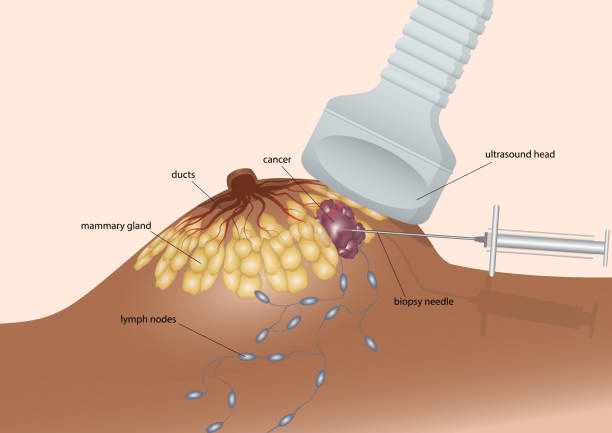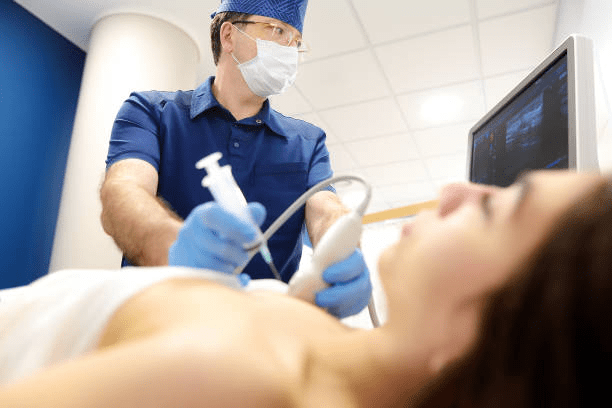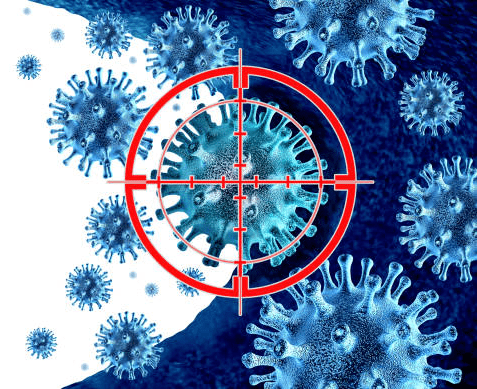If Breast Biopsy Is Negative Can It Still Be Cancer?

Recurrent Breast Cancer After Mastectomy
May 8, 2024
Fibroadenoma Over Age 50
May 31, 2024
A breast biopsy is an important diagnostic tool used to determine the presence of breast cancer.
Have you ever wondered if a negative breast biopsy could still mean the presence of breast cancer?
It’s a question that often lingers in the minds of those undergoing diagnostic procedures. In this blog, Dr. Garvit Chitkara, a renowned breast cancer surgeon in Mumbai, sheds light on this topic. He provides valuable insights into the complexities of breast biopsy results and what they may signify.
Join us as we delve into the important question – If breast biopsy is negative, can it still be cancer? Let’s gain a deeper understanding of breast cancer diagnosis and treatment options.
Can A Breast Biopsy Be Negative And Still Indicate Breast Cancer?
“Absolutely,” says Dr. Garvit Chitkara, a skilled breast cancer surgeon in Mumbai. “A breast biopsy can yield a negative result while cancer is still present. Factors such as sampling error, tumor location, and size, as well as the skill of the person doing the biopsy, can contribute to false-negative results. Additionally, certain types of breast cancer can spread in a pattern that is harder to detect in a standard biopsy sample.”
He further explains:
“Some breast lesions are categorized as high-risk lesions. Although not cancerous themselves, they can significantly increase the risk of developing breast cancer in the future. Examples include atypical hyperplasia or Lobular Carcinoma in Situ (LCIS). In such cases, a negative biopsy might still lead to close monitoring and additional preventive measures.
Patients must discuss the implications of their biopsy results with their healthcare provider. They should understand the need for possible further investigations. This ensures comprehensive breast health management.”
Worried about a negative breast biopsy result? Consult with Dr. Garvit Chitkara for expert insights and further evaluation. Take charge of your breast health today.
Let’s understand the negative breast biopsy factors and their relation to breast cancer.
Factors That Can Contribute To False-Negative Results In Breast Biopsy

The question ‘If breast biopsy is negative can it still be cancer?’ lingers in a lot of people’s minds. Here’s a breakdown of the factors that can contribute to false-negative results in breast biopsy:
Sampling Error
Sometimes, the biopsy needle may not collect tissue from the exact area of concern. This could be due to the tumor being located deep within the breast tissue or near the chest wall. The health professional may miss it during biopsy sampling, leading to a false-negative result.
Tumor Characteristics
Certain types of breast cancer, such as lobular carcinoma, may not form a distinct mass. Invasive lobular carcinoma tends to spread in a single-file pattern. The biopsy needle can miss them or not detect them in a small biopsy sample.
Pathologist Expertise
Interpretation of biopsy results requires skill and experience. A less experienced pathologist may overlook subtle signs of cancer or misinterpret benign changes as normal tissue.
Technique Used
The method used to perform the biopsy can affect the accuracy of the results. Core needle biopsy removes small tissue samples and may miss cancer cells.
Tumor Size
Small tumors may be more challenging to detect during biopsy. The technician may fail to detect microscopic foci of cancer cells within the breast if the biopsy needle does not sample the precise location of the tumor.
Understanding these factors is essential for patients and healthcare providers to recognize the limitations of biopsy results. This will prompt additional testing or surveillance if there is a high suspicion of breast cancer despite a negative biopsy result.
Let’s further explore the question, ‘If breast biopsy is negative can it still be cancer?’. What do the negative results indicate?
Understanding The Types of Negative Results: Benign vs. Suspicious vs. Atypical
Benign: Benign indicates no evidence of cancer, which is typically reassuring but may require monitoring for changes.
Suspicious: Suggests the presence of abnormal cells that warrant further evaluation to rule out cancer.
Atypical: Indicates cellular changes that are not definitively cancerous but may increase the cancer risk in the future.
So, what typically happens when a patient hears their breast biopsy results are negative? Let’s find out!
What Happens If A Breast Biopsy Is Negative?
A negative breast biopsy means the doctor did not find any cancerous or abnormal cells in the tissue sample. It indicates that there is no evidence of breast cancer or any other concerning condition in the biopsied area. Patients often experience a sense of relief and reassurance upon receiving a negative biopsy result.
Knowing that there are no signs of cancer can alleviate anxiety and uncertainty. However, taking proactive steps can go a long way in ensuring ongoing breast health and peace of mind.
What Is The Next Step After A Negative Breast Biopsy?

Dr. Chitkara, a qualified breast cancer surgeon in Mumbai, advises:
“A negative biopsy does not guarantee that there are no issues with the breast. Sometimes, symptoms such as a palpable lump or breast changes persist despite a negative biopsy result. There could still be other benign conditions present, like fibrocystic changes, fibroadenomas, or benign breast tumors. Additional imaging tests or repeat biopsies must be performed to investigate the cause of symptoms.
Also, the absence of cancer in the biopsy sample does not eliminate the possibility of developing breast cancer in the future. Regular self-exams and maintaining a healthy lifestyle are vital. Patients must have regular breast screenings to monitor for changes or developments. Patients and their healthcare providers should discuss individual risk factors for breast cancer. This will help the doctors develop a personalized plan for ongoing monitoring and risk reduction.”
With 15+ years of experience, Dr. Chitkara is among the preferred doctors for breast cancer surgery in Mumbai.
Do you have any questions or concerns about symptoms despite a negative biopsy result? Please do not hesitate to express them.
Seek the help and guidance of a breast cancer specialist today. Take proactive steps towards early detection and prevention of breast cancer.
What Happens If Cancer Is Detected After A Negative Biopsy?
Dr. Garvit Chitkara, a proficient breast cancer surgeon, explains what happens if a patient is diagnosed with cancer:
Consultation with Oncologists:
Patients meet with oncologists to discuss treatment options and develop a personalized treatment plan.
Treatment Initiation:
Treatment may include surgery, chemotherapy, radiation therapy, targeted therapy, or a combination of these modalities. Let’s get a better understanding of these treatment approaches.
1. Surgery
Surgery involves removing the cancerous tumor and surrounding tissue to eliminate cancer cells. This reduces the risk of cancer recurrence. The surgery types include:
- Lumpectomy (removal of the tumor and surrounding tissue)
- Mastectomy (removal of the entire breast)
2. Chemotherapy

Chemotherapy uses powerful drugs to kill or prevent cancer cells from growing and dividing. The healthcare provider can give it orally or intravenously. The method depends on the specific drugs and treatment regimen. Chemotherapy helps to:
- shrink tumors before surgery
- destroy remaining cancer cells after surgery
- treat cancer that has spread to other parts of the body
3. Radiation Therapy

Radiation therapy uses high-energy beams to target and destroy cancer cells. It is typically delivered externally through a machine directed at the affected area. Radiation therapy occurs after surgery to:
- kill any remaining cancer cells
- reduce the risk of recurrence
- alleviate symptoms in advanced cases
4. Targeted Therapy

Targeted therapy targets specific molecules or pathways involved in cancer growth and progression. These drugs are usually given orally or through intravenous infusion. It aims to interfere with specific abnormalities in cancer cells. This leads to their destruction or inhibition of growth while minimizing damage to healthy cells.
Ongoing Monitoring

Patients undergo regular follow-up appointments to monitor treatment response and manage any side effects.
Psychological Support:
Emotional support is provided to patients and their families to cope with the challenges of cancer diagnosis and treatment.
Have you or a loved one been diagnosed with cancer? Take the next step towards comprehensive care and support. Schedule a consultation with an experienced breast cancer expert today. Your journey to healing starts here.
Conclusion
‘If breast biopsy is negative can it still be cancer?’ is a normal question. While a negative breast biopsy result is generally reassuring, it’s essential to understand that false-negative results can occur. Factors such as sampling error and health care provider’s expertise can contribute to inaccuracies in biopsy results. Understanding the types of negative results and the implications of each is crucial for informed decision-making and follow-up care.
Stay proactive about breast health and work closely with your healthcare providers. By doing this, you can navigate the complexities of breast cancer diagnosis with confidence.
FAQs
What percentage of breast biopsies are cancer?
While many breast biopsies reveal benign findings, approximately 20% of breast biopsies result in a cancer diagnosis. However, the likelihood of cancer varies depending on factors such as:
- age
- family history
- characteristics of the breast abnormality
Are there additional tests or screenings recommended after a negative breast biopsy?
Additional tests or screenings may be recommended depending on individual circumstances. This may include:
- regular clinical breast exams
- mammograms
- other imaging studies to monitor for any changes in breast tissue over time
What should I do if I still have symptoms despite a negative breast biopsy?
Sometimes, symptoms can persist despite a negative breast biopsy. Dr. Chitkara advises patients to follow up with their healthcare provider for further evaluation. Additional imaging tests or repeat biopsies may be necessary to investigate the cause of symptoms and ensure comprehensive care.
What is the next step after a positive breast biopsy?
If a breast biopsy yields a positive result for cancer, discuss treatment options with your healthcare provider. They will develop a personalized treatment plan tailored to your needs. This may include:
- surgery
- chemotherapy
- radiation therapy
- targeted therapy
- combination of these modalities to effectively manage the cancer and optimize outcomes
Reference Links:
https://www.roswellpark.org/cancertalk/202010/can-cancer-biopsy-result-be-wrong

